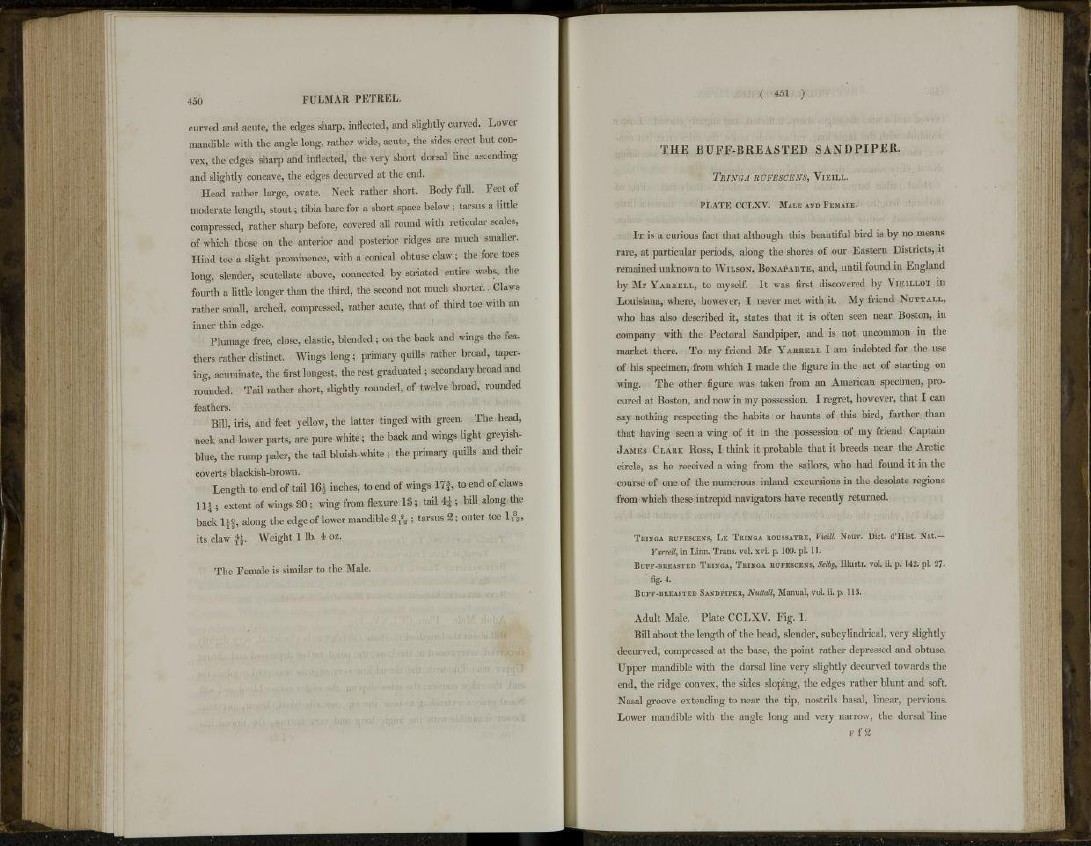
450 FULMAR PETREL,
curved and acute, the edges sharp, inflected, and slightly curved. Lower
mandible with the angle long, rather wide, acute, the sides erect but convex,
the edges sharp and inflected, the very short dorsal line ascending
and slightly concave, the edges decurved at the end.
Head rather large, ovate. Neck rather short. Body full. Feet of
moderate length, stout; tibia bare for a short space below; tarsus a little
compressed, rather sharp before, covered all round with reticular scales,
of which those on the anterior and posterior ridges are much smaller.
Hind toe a slight prominence, with a conical obtuse claw ; the fore toes
long, slender, scutellate above, connected by striated entire webs, the
fourth a little longer than the third, the second not much shorter.. Claws
rather small, arched, compressed, rather acute, that of third toe with an
inner thin edge.
Plumage free, close, elastic, blended ; on the back and wings the feathers
rather distinct. Wings long; primary quills rather broad, tapering,
acuminate, the first longest, the rest graduated ; secondary broad and
rounded. Tail rather short, slightly rounded, of twelve broad, rounded
feathers.
Bill, iris, and feet yellow, the latter tinged with green. The head,
neck and lower parts, are pure white; the back and wings light greyishblue,
the rump paler, the tail bluish-white ; the primary quills and their
coverts blackish-brown.
Length to end of tail 16-£ inches, to end of wings 17|, to end of claws
114 ; extent of wings 30 ; wing from flexure 13; tail 4£ ; bill along the
back l^g, along the edge of lower mandible %j% ; tarsus 2; outer toe 1 ^ ,
its claw Weight 1 lb. 4 oz.
The Female is similar to the Male.
( 451 )
T H E B U F F - B R E A S T E D S A N D P I P E R.
TRINGA RUFESCENS, VIEILL.
PLATE CCLXV. MALE AND FEMALE.
IT is a curious fact that although this beautiful bird is by no means
rare, at particular periods, along the shores of our Eastern Districts, it
remained unknown to WILSON, BONAPARTE, and, until found in England
by Mr YARRELL, to myself. It was first discovered by VIEILLOT in
Louisiana, where, however, I never met with it. My friend NUTTALL,
who has also described it, states that it is often seen near Boston, in
company with the Pectoral Sandpiper, and is not uncommon in the
market there. To my friend Mr YARRELL I am indebted for the use
of his specimen, from which I made the figure in the act of starting on
wing. The other figure was taken from an American specimen, procured
at Boston, and now in my possession. I regret, however, that I can
say nothing respecting the habits or haunts of this bird, farther than
that having seen a wing of it in the possession of my friend Captain
JAMES CLARK Ross, I think it probable that it breeds near the Arctic
circle, as he received a wing from the sailors, who had found it in the
course of one of the numerous inland excursions in the desolate regions
from which these intrepid navigators have recently returned.
TttiNGA RUFESCENS, LE TRINGA ROUSSATRE, Vieill. Nouv. Diet. d'Hist. Nat.—
Yarrell, in Linn. Trans, vol. xvi. p. 109. pi. 11.
BUFF-BREASTED TRINGA, TRINGA RUFESCENS, Selby, Illustr. vol. ii. p. 142. pi. 27-
BUFF-BREASTED SANDPIPER, Nuttall, Manual, vol. ii. p. 113.
Adult Male. Plate CCLXV. Fig. 1.
Bill about the length of the head, slender, subeylindrical, very slightly
decurved, compressed at the base, the point rather depressed and obtuse.
Upper mandible with the dorsal line very slightly decurved towards the
end, the ridge convex, the sides sloping, the edges rather blunt and soft.
Nasal groove extending to near the tip, nostrils basal, linear, pervious.
Lower mandible with the angle long and very narrow, the dorsal line
F f 2